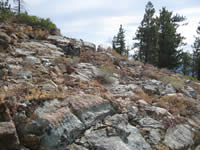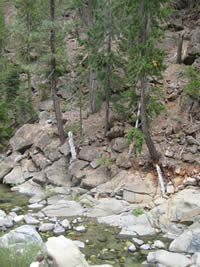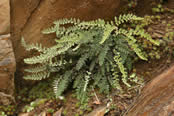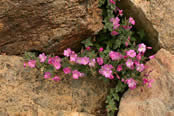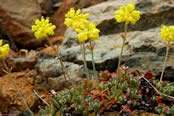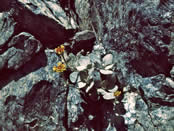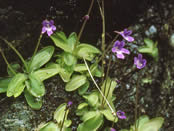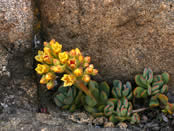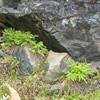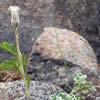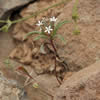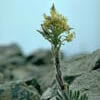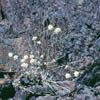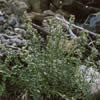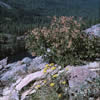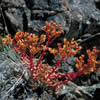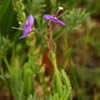USDA Forest Service Celebrating Wildflowers
|
|
|
Serpentine Rock Outcrops
The ultramafics of the Klamath-Siskiyou bioregion are a place where the bones of the earth show. Vegetation does not blanket and soften the slopes of this landscape. Rocks are exposed everywhere, sometimes with a thin cover of shrubs or herbs, sometimes with trees emerging from crevices, and sometimes apparently barren at first glance. The harsh conditions imposed on plants by the climate and the mineralogy of serpentine rocks slow soil development. The stunted vegetation creates so little organic matter. The Mediterranean climate of wet winters and dry summers means that the combination of warmth and moisture needed for decomposition of dead plant material is present for only a few weeks of the year. Serpentine rock outcrops characterize all elevations of this landscape, from grasslands and savannahs at low elevations, to the glaciated serpentine rock summits of the eastern Trinity Alps and Eddys, and in the dramatic river canyons of the Rogue, Smith, upper Trinity, and South Fork Sacramento Rivers. Plants that live in these places are able to find the moisture and shelter they need by sending their roots deep into rock crevices. Sometimes surface water emerges to drip down the rocks, creating habitat for moisture-loving plants such as Cypripedium californicum (California lady’s slipper orchid), Adiantum aleuticum (five-finger fern) and Pinguicula macroceras (horned butterwort). The beauty of the rocks is enhanced by the loveliness of the wildflowers that inhabit them, creating breathtaking natural rock gardens. Some of the rarest and most beautiful Klamath-Siskiyou serpentine endemic plants are rock outcrop inhabitants: Arabis macdonaldiana (Macdonald’s rockcress), Galium serpenticum ssp. scotticum (Scott Mountain bedstraw), and Sedum moranii (Rogue River stonecrop).
Photo Gallery
Our thanks to CalPhotos and its many contributors for many of the pictures in this photo gallery. |
|
| NOTE: PDF format links require the Adobe Acrobat Reader to view. | |
| top | Disclaimers | FOIA | Privacy Policy | Quality of Information | Photo Credits & Use |
Location: http://www.fs.fed.us/wildflowers/communities/serpentines/communities/rock_outcrops.shtml
Last modified: Wednesday, 03-Dec-2008 13:54:25 EST
